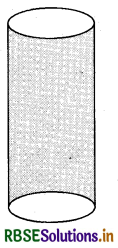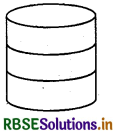RBSE Solutions for Class 9 Maths Chapter 13 Surface Areas and Volumes Ex 13.2
Rajasthan Board RBSE Solutions for Class 9 Maths Chapter 13 Surface Areas and Volumes Ex 13.2 Textbook Exercise Questions and Answers.
Rajasthan Board RBSE Solutions for Class 9 Maths in Hindi Medium & English Medium are part of RBSE Solutions for Class 9. Students can also read RBSE Class 9 Maths Important Questions for exam preparation. Students can also go through RBSE Class 9 Maths Notes to understand and remember the concepts easily. Practicing the class 9 math chapter 13 hindi medium textbook questions will help students analyse their level of preparation.
RBSE Class 9 Maths Solutions Chapter 13 Surface Areas and Volumes Ex 13.2
Question 1.
The curved surface area of a right circular cylinder of height 14 cm is 88 cm2. Find the diameter of the base of the cylinder,
Answer:
Let r be the radius of the base, h = 14 cm is given as height of the cylinder. Then,
Curved surface area = 2πrh
So, 88 = 2 × \(\frac{22}{7}\) × r × 14 ⇒ r = \(\frac{88 \times 7}{2 \times 22 \times 14}\) = 1
∴ Diameter of the base = 2r = 2 × 1 cm = 2 cm.

Question 2.
It is required to make a closed cylindrical tank of height 1 m and base diameter 140 cm from a metal sheet. How many square metres of the sheet are required for the same?
Answer:
Let r be the radius of the base and h be the height of the cylinder. Metal sheet required to make a closed cylindrical tank.
Total surface area = 2πr(h + r)
= 2 × \(\frac{22}{7} \)× 0.7 (1 + 0.70) m2 [∵ h = 1 m, r = \(\frac{140}{2}\) cm = 70 cm = 0.70 m]
= 2 × 22 × 0.1 × 1.70 m2
= 7.48 m2
Hence, the sheet required = 7.48 m2.
Question 3.
A metal pipe is 77 cm long. The inner diameter of a cross-section is 4 cm, the outer diameter being 4.4 cm (see figure). Find its :

(i) inner curved surface area,
(ii) outer curved surface area,
(iii) total surface area.
Answer:
We have:
R = external radius = \(\frac{4.4}{2}\) cm = 2.2 cm
r = internal radius = \(\frac{4}{2}\) cm = 2 cm
h = length of the pipe = 77 cm.
(i) Inner curved surface area = 2πrh
= 2 × \(\frac{22}{7}\) × 2 × 77 cm2 = 968 cm2
(ii) Outer curved surface area = 2πRh = 2 × \(\frac{22}{7}\) × 2.2 × 77 cm2 = 1064.8 cm2
(iii) Total surface area of a pipe = Inner curved surface area + Outer curved surface area + Areas of two bases
= 2πrh + 2πRh + 2π(R2 - r2)
= [968 +1064.8 + 2 × \(\frac{22}{7}\)(4.84 - 4)] cm2
= (2032.8 + \(\frac{44}{7}\) + 0.84) cm2
= (2032.8 + 5.28) cm2 = 2038.08 cm2.
Question 4.
The diameter of a roller is 84 cm and its length is 120 cm. It takes 500 complete revolutions to move once over to level a playground. Find the area of the playground in m2.
Answer:
The length of the roller is 120 cm, i.e. h = 1.2 m and radius of the cylinder {i.e, roller) = \(\frac{84}{2}\) cm = 42 cm = 0.42 m.
Area covered by the roller in one revolution
= Its curved surface area 2πrh
= (2 × \(\frac{22}{7}\) × 0.42 × 1.2)m2 = 3.168 m2
Area of the playground = Distance covered by the roller in 500 revolutions
= (500 × 3.168) m2 = 1584 m2.
Question 5.
A cylindrical pillar is 50 cm in diameter and 3.5 m in height. Find the cost of painting the curved surface of the pillar at the rate of ₹ 12.50 per m2.
Answer:
Let r be the radius of the base and h be the height of the pillar.
∴ r = \(\frac{50}{2}\) cm = 25 cm = 0.25 m and h = 3.5 m.
Curved surface area = 2πrh = (2 × \(\frac{22}{7}\) × 0.25 × 3.5 )m2 = 5.5 m2
Cost of painting the curved surface @ ₹ 12.50 per m2 = ₹ (5.5 × 12.5) = ₹ 68.75.

Question 6.
Curved surface area of a right circular cylinder is 4.4 m2. If the radius of the base of the cylinder is 0.7 m, find its height.
Answer:
Let r be the radius of the base and h be the height of the cylinder.
Now, curved surface area = 4.4 m2
So, 2πrh = 4.4
or 2 × \(\frac{22}{7}\) × 0.7 × h = 4.4 (∵ r = 0.7 m)
or h = \(\left(\frac{4.4 \times 7}{2 \times 22 \times 0.7}\right)\) m = 1 m
Thus, the height of the cylinder is 1 metre.
Question 7.
The inner diameter of a circular well is 3.5 m. It is 10 m deep. Find :
(i) its inner curved surface area,
(ii) the cost of plastering this curved surface at the rate of ₹ 40 per m2.
Answer:
(i) Let r be the radius of the base and h be depth of the well.
Now, curved surface area = 2πrh
= (2 × \(\frac{22}{7} \times \frac{3.5}{2}\) × 10) m2 = 110 m2
(ii) Cost of plastering is ₹ 40 per m2.
∴ Cost of plastering the curved surface = ₹ (110 × 40) = ₹ 4400.
Question 8.
In a hot water heating system, there is a cylindrical pipe of length 28 m and diameter 5 cm. Find the total radiating surface in the system.
Answer:
Total radiating surface in the system = Curved surface area of the pipe
= 2πrh, where r = \(\frac{5}{2}\) cm = 2.5 cm = m = 0.025 m and h = 28 m
= (2 × \(\frac{22}{7}\) × 0.025 × 28) m2 = 4.4 m2.
Question 9.
Find :
(i) the lateral or curved surface area of a cylindrical petrol storage tank that is 4.2 m in diameter and 4.5 m high.
(ii) how much steel was actually used, if \(\frac{1}{12}\) of the steel actually used was wasted in making the tank.
Answer:
(i) Here, r = \(\left(\frac{4.2}{2}\right)\)m = 2.1 m and h = 4.5 m.
Curved surface area = 2πrh
= (2 × \(\frac{22}{7}\) × 2.1 × 4.5)m2 = 59.4 m2
Steel used = (2πrh + 2πr2)
= (59.4 + 2 × \(\frac{22}{7}\) × 2.1 × 2.1)m2
= (59.4 + 27.72) m2
= 87.12 m2
(ii) Since \(\frac{1}{12}\) of the actual steel used was wasted, the area of the steel which is used in making of the tank = (1 - \(\frac{1}{12}\)) of x = \(\frac{11}{12}\) of x.
∴ \(\frac{11}{12}\) × x = 87.12 ⇒ x = \(\frac{87.12 \times 12}{11}\) = 95.04 m2
Hence, the actual area of the steel used = 95.04 m2.
Question 10.
In the figure, you see the frame of a lampshade. It is to he covered with a decorative cloth. The frame has a base diameter of 20 cm and height of 30 cm. A margin of 2.5 cm is to be given for folding it over the top and bottom of the frame. Find how much cloth is required for covering the lampshade.

Solution : Here r = \(\left(\frac{20}{2}\right)\) cm = 10 cm and h = 30 cm + 2 × 2.5 cm (i.e. margin)
= 35 cm.
Cloth required for covering the lampshade = Its curved surface area
= 2πrh
= (2 × \(\frac{22}{7}\) × 10 × 35) cm2 = 2200 cm2.

Question 11.
The students of a Vidyalaya were asked to participate in a competition for making and decorating penholders in the shape of a cylinder with a base, using cardboard. Each penholder was to he of radius 3 cm and height 10.5 cm. The Vidyalaya was to supply the competitors with cardboard. If there were 35 competitors, how much cardboard was required to he bought for the competition?
Answer:
Cardboard required by each competitor
= Curved surface area of one penholder + Base area
= 2πrh + πr2 where r = 3 cm, h = 10.5 cm
= [(2 × \(\frac{22}{7}\) × 3 × 10.5) + \(\frac{22}{7}\) × 9
= (198 + 28.28) cm2 = 226.28 cm2 (approx.)
Cardboard required for 35 competitors
= (35 × 226.28) cm2 = 7920 cm2 (approx.)

- RBSE Solutions for Class 9 Maths Chapter 6 रेखाएँ और कोण Ex 6.3
- RBSE Solutions for Class 9 Maths Chapter 14 सांख्यिकीEx 14.3
- RBSE Solutions for Class 9 Maths Chapter 13 पृष्ठीय क्षेत्रफल एवं आयतन Ex 13.5
- RBSE Solutions for Class 9 Maths Chapter 13 पृष्ठीय क्षेत्रफल एवं आयतन Ex 13.4
- RBSE Solutions for Class 9 Maths Chapter 10 Circles Ex 10.3
- RBSE Solutions for Class 9 Maths Chapter 10 Circles Ex 10.2
- RBSE Solutions for Class 9 Maths Chapter 10 Circles Ex 10.1
- RBSE Solutions for Class 9 Maths Chapter 9 Areas of Parallelograms and Triangles Ex 9.2
- RBSE Solutions for Class 9 Maths Chapter 11 Constructions Ex 11.1
- RBSE Solutions for Class 9 Maths Chapter 9 Areas of Parallelograms and Triangles Ex 9.3
- RBSE Solutions for Class 9 Maths Chapter 11 Constructions Ex 11.2